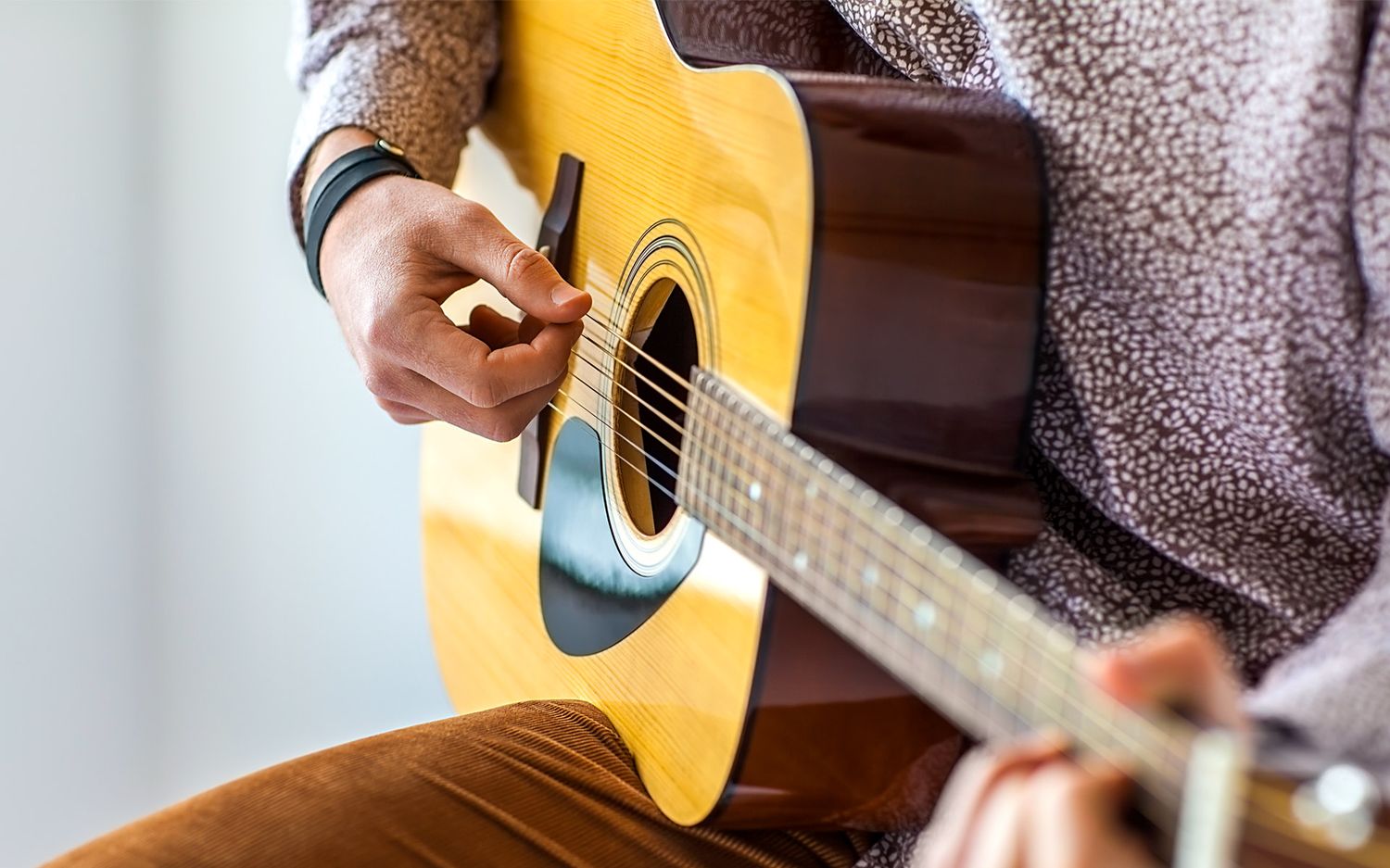Home>Instruments>Guitar>How To Learn Lead Guitar Techniques


Guitar
How To Learn Lead Guitar Techniques
Modified: February 15, 2024
Learn essential lead guitar techniques with our comprehensive guide. Master the art of playing guitar with expert tips and tutorials. Start your journey today!
(Many of the links in this article redirect to a specific reviewed product. Your purchase of these products through affiliate links helps to generate commission for AudioLover.com, at no extra cost. Learn more)
Table of Contents
Introduction
Learning lead guitar techniques is an exhilarating journey that opens up a world of expressive possibilities for guitarists. Unlike rhythm guitar, which provides the foundational chord progressions in a song, lead guitar is all about weaving melodic lines, creating captivating solos, and adding flair to musical compositions. Whether you're a beginner looking to delve into the realm of lead guitar or an intermediate player aiming to refine your skills, understanding and mastering lead guitar techniques can significantly elevate your playing style and musical expression.
In this comprehensive guide, we will explore the fundamental aspects of lead guitar techniques, from essential scales and bending to developing speed, accuracy, improvisation, and integrating these techniques into songs. By delving into these key areas, you'll gain valuable insights into the intricate art of lead guitar and discover the tools to enhance your musical prowess.
Throughout this journey, we'll emphasize the importance of practice, patience, and perseverance. Mastering lead guitar techniques doesn't happen overnight; it requires dedication, consistent practice, and a willingness to push beyond your comfort zone. As we embark on this exploration, remember that every guitarist, regardless of their current skill level, once stood at the beginning of their own musical odyssey. With the right guidance and a passion for learning, you can unlock the captivating world of lead guitar and infuse your musical journey with creativity and expression.
Understanding Lead Guitar Techniques
Lead guitar techniques encompass a diverse set of skills that empower guitarists to take center stage and deliver captivating melodies, solos, and improvisations. Unlike rhythm guitar, which focuses on strumming chords to support the song’s harmonic structure, lead guitar demands a deep understanding of scales, phrasing, and expressive techniques. To excel in this domain, it’s crucial to grasp the nuances of lead guitar and the various components that contribute to its distinct sound and style.
One of the primary elements of lead guitar is the mastery of scales. Scales serve as the building blocks for crafting melodic phrases and solos, providing a roadmap for navigating the fretboard with precision and musicality. By familiarizing yourself with scales such as the pentatonic, blues, and modes, you can expand your improvisational vocabulary and infuse your playing with depth and emotion.
Furthermore, lead guitar techniques encompass expressive skills such as bending and vibrato, which add character and personality to your playing. Bending involves subtly altering the pitch of a note by physically bending the string, while vibrato introduces a subtle, pulsating effect to sustained notes, imbuing them with warmth and expressiveness. These techniques are integral to shaping your sonic identity as a lead guitarist and infusing your playing with emotion and dynamism.
As you delve deeper into lead guitar techniques, you’ll encounter the crucial aspects of speed and accuracy. Developing the dexterity to execute rapid passages with precision is a hallmark of proficient lead guitarists. This proficiency is achieved through focused practice and a commitment to refining your technique, ultimately enabling you to navigate intricate musical passages with fluidity and control.
Understanding lead guitar techniques is not merely about technical proficiency; it’s also about harnessing the art of improvisation. The ability to spontaneously craft compelling melodies and solos is a defining trait of accomplished lead guitarists. By honing your improvisational skills, you can confidently explore the fretboard, respond intuitively to musical contexts, and create captivating musical narratives in real time.
As we delve into the intricacies of lead guitar techniques, it’s essential to approach this journey with an open mind and a willingness to embrace the challenges and rewards that come with mastering this expressive art form. By immersing yourself in the multifaceted world of lead guitar techniques, you’ll unlock a realm of musical creativity and elevate your playing to new heights.
Essential Scales for Lead Guitar
Mastering essential scales is a cornerstone of lead guitar proficiency, providing a framework for crafting captivating melodies, improvising solos, and navigating the fretboard with confidence. These foundational scales serve as the musical vocabulary from which lead guitarists draw inspiration and create expressive musical narratives. By familiarizing yourself with essential scales, you can expand your improvisational toolkit and infuse your playing with depth and emotion.
One of the most widely utilized scales in lead guitar playing is the pentatonic scale. Renowned for its versatility and emotive qualities, the pentatonic scale empowers guitarists to effortlessly craft soulful, blues-infused solos and melodic passages. Its five-note structure offers a user-friendly entry point for aspiring lead guitarists while providing a rich sonic palette for seasoned players to explore and expand upon.
Another pivotal scale in the lead guitar arsenal is the blues scale. Rooted in the expressive traditions of blues music, this scale injects raw emotion and grit into lead guitar playing, allowing guitarists to evoke intense feelings and convey poignant musical expressions. The blues scale’s distinctive intervals and tonal characteristics make it a potent tool for infusing lead guitar solos with soul-stirring authenticity and raw energy.
Expanding beyond the pentatonic and blues scales, delving into modal scales opens up a world of harmonic richness and melodic possibilities. Modal scales, such as the Dorian, Mixolydian, and Phrygian modes, offer unique tonal flavors and evoke diverse emotional landscapes, enabling lead guitarists to craft evocative solos and melodic motifs that transcend conventional tonalities.
While mastering these essential scales forms the bedrock of lead guitar proficiency, it’s important to approach them with a mindset of creative exploration and musical discovery. Beyond the technical aspects, understanding the emotive qualities and expressive potential of each scale is paramount. By internalizing the nuances of these scales, you can imbue your lead guitar playing with authenticity, depth, and the ability to connect with listeners on a profound emotional level.
Embracing the journey of mastering essential scales for lead guitar entails not only honing technical prowess but also cultivating a deep appreciation for the expressive power of music. As you immerse yourself in the sonic tapestry of essential scales, you’ll embark on a transformative musical odyssey, where each scale becomes a brushstroke in the canvas of your musical expression, allowing you to paint vivid sonic landscapes and convey profound emotions through your lead guitar playing.
Mastering Bending and Vibrato
Bending and vibrato are two quintessential techniques that imbue lead guitar playing with expressiveness, emotion, and individuality. Mastering these techniques not only enhances the sonic character of your playing but also allows you to infuse your melodies and solos with nuanced phrasing and dynamic tonal variations. As you delve into the art of bending and vibrato, you’ll uncover the transformative power these techniques hold in shaping your musical identity as a lead guitarist.
Bending, a hallmark of lead guitar expression, involves subtly altering the pitch of a note by physically bending the string. This technique enables guitarists to inject notes with emotive inflections, seamlessly transitioning between pitches and adding a vocal-like quality to their playing. Whether executing half-step bends, whole-step bends, or microtonal bends, mastering the control and finesse of bending is essential for crafting evocative, soulful solos and melodic lines.
Furthermore, vibrato serves as a vital tool for infusing sustained notes with warmth, depth, and expressive character. By imparting a subtle, pulsating effect to sustained notes, vibrato elevates the emotional impact of a melody, adding a human touch to the guitar’s voice. The nuances of vibrato, including its speed, width, and rhythmic feel, allow guitarists to convey a spectrum of emotions, from tender vulnerability to impassioned intensity, creating a profound connection with the listener.
Mastering bending and vibrato extends beyond technical proficiency; it encompasses developing a keen sense of musicality and understanding the subtleties of phrasing. Effective employment of these techniques involves intuitive expression, where the guitarist’s emotions and intentions are translated into the nuanced articulation of each note. As you refine your bending and vibrato techniques, you’ll cultivate a signature sound that reflects your musical sensibilities and resonates with authenticity.
Embracing the journey of mastering bending and vibrato entails dedicated practice, attentive listening, and a commitment to harnessing the emotive potential of these techniques. By honing the art of bending and vibrato, you’ll not only expand your technical prowess but also unlock the ability to communicate profound emotions through your lead guitar playing, establishing a powerful connection with your audience and leaving a lasting impression with every note you articulate.
Developing Speed and Accuracy
Developing speed and accuracy is a pivotal aspect of mastering lead guitar techniques, empowering guitarists to navigate intricate passages, execute dynamic solos, and express their musical ideas with precision and fluency. While speed alone does not define virtuosity, the ability to play fast passages with impeccable accuracy and control enhances a guitarist’s expressive capabilities and opens up new avenues for creative exploration.
One fundamental approach to enhancing speed and accuracy is through disciplined practice routines that focus on technical exercises, scale sequences, and chromatic drills. These exercises not only bolster finger dexterity and coordination but also cultivate muscle memory, enabling guitarists to perform complex passages with fluidity and control. By gradually increasing the tempo and challenging oneself with progressively demanding exercises, guitarists can elevate their playing to new levels of speed and precision.
Moreover, the concept of accuracy extends beyond playing the correct notes; it encompasses the nuances of articulation, dynamics, and phrasing. Attaining accuracy involves refining the subtleties of each note, ensuring that every articulation, bend, and vibrato is executed with intention and clarity. By honing the precision of your playing, you can convey the full spectrum of musical expression, from delicate nuances to blistering runs, with unwavering control and finesse.
Achieving speed and accuracy also entails developing a relaxed and efficient playing technique. Tension in the hands and fingers can impede fluidity and hinder precision, making it essential to cultivate a relaxed yet controlled approach to playing. By maintaining a relaxed posture, optimizing hand positioning, and employing efficient picking and fretting techniques, guitarists can enhance their speed and accuracy while minimizing physical strain and fatigue.
As you embark on the journey of developing speed and accuracy, it’s crucial to approach the process with patience and persistence. Mastery in this domain is not achieved overnight but through consistent, focused practice and a commitment to continual improvement. By setting incremental goals, tracking your progress, and embracing the challenges along the way, you can steadily enhance your speed and accuracy, unlocking newfound capabilities and elevating your lead guitar playing to exhilarating heights.
Ultimately, the pursuit of speed and accuracy in lead guitar playing is a dynamic and rewarding endeavor, where technical proficiency converges with artistic expression. By honing your speed and accuracy, you’ll not only expand your musical capabilities but also unleash a newfound freedom to articulate your musical ideas with unparalleled precision and fluidity, captivating listeners with the electrifying energy and dynamism of your lead guitar prowess.
Improvisation and Soloing
Improvisation and soloing lie at the heart of lead guitar expression, offering guitarists the freedom to spontaneously create captivating melodies, craft dynamic solos, and infuse their playing with personalized musical narratives. The art of improvisation transcends rote memorization and technical proficiency, inviting guitarists to tap into their creativity, intuition, and emotional depth to shape evocative musical journeys in real time.
At the core of improvisation is the ability to navigate the fretboard with fluency and confidence, drawing from a rich palette of scales, arpeggios, and melodic motifs. By internalizing these musical elements and developing a keen ear for harmonic contexts, guitarists can fluidly respond to the musical landscape, weaving melodic tapestries that reflect the moment’s emotional nuances and expressive possibilities.
Moreover, effective improvisation encompasses rhythmic awareness and the ability to craft compelling phrasing. By embracing rhythmic diversity, syncopation, and melodic tension, guitarists can imbue their improvisations with dynamic momentum and engaging rhythmic interplay, captivating listeners with the ebb and flow of their musical storytelling.
When delving into soloing, it’s essential to approach each solo as a narrative, a musical conversation that unfolds with purpose and emotion. Crafting a memorable solo involves building tension and release, exploring thematic development, and delivering climactic moments that resonate with the song’s emotional core. By infusing your solos with a sense of storytelling and emotional depth, you can elevate the musical impact of your lead guitar playing.
Embracing the art of improvisation and soloing also entails developing a strong sense of melodic and harmonic vocabulary, allowing you to effortlessly articulate your musical ideas in real time. By cultivating a repertoire of melodic motifs, licks, and expressive techniques, you can enrich your improvisations and solos with a diverse array of musical colors and textures, showcasing your unique musical identity with every note.
The journey of improvisation and soloing is a deeply personal and transformative exploration, where technical proficiency converges with artistic intuition. By honing your improvisational skills and crafting compelling solos, you’ll not only expand your musical capabilities but also unlock a boundless realm of creative expression, infusing your lead guitar playing with spontaneity, emotion, and the power to captivate audiences with the raw energy and authenticity of your musical storytelling.
Incorporating Techniques into Songs
Translating lead guitar techniques into the context of songwriting and musical performance is a transformative process that empowers guitarists to infuse their compositions with expressive depth, captivating solos, and dynamic melodic embellishments. By integrating a diverse array of techniques into songs, from scales and bending to vibrato and speed-driven passages, guitarists can elevate their musical arrangements and performances, creating immersive sonic experiences that resonate with listeners.
One pivotal aspect of incorporating lead guitar techniques into songs is the art of crafting melodic hooks and memorable motifs. By leveraging scales and arpeggios, guitarists can weave intricate melodic passages that serve as focal points within a song, leaving a lasting imprint on the listener’s memory. These melodic motifs, whether introduced as intros, interludes, or standalone solos, enrich the musical tapestry, adding depth and emotional resonance to the composition.
Furthermore, lead guitar techniques play a pivotal role in shaping the sonic dynamics of a song. From soulful bends and expressive vibrato to lightning-fast runs and arpeggio sweeps, these techniques imbue the music with a diverse range of tonal textures and emotive qualities, creating dynamic contrasts and evocative sonic landscapes. Whether conveying introspective introspection or unleashing electrifying energy, lead guitar techniques enrich the emotional palette of a song, enhancing its impact and resonance.
Effective incorporation of lead guitar techniques also involves seamless integration with the song’s overarching narrative and emotional arc. By aligning the expressive nuances of techniques with the song’s lyrical themes, mood, and sonic atmosphere, guitarists can imbue their performances with a sense of musical storytelling, creating a cohesive and immersive sonic experience for the audience.
Moreover, the integration of lead guitar techniques extends beyond standalone solos, encompassing subtle embellishments, melodic variations, and harmonic textures that enrich the song’s arrangement. Whether through tasteful phrasing, emotive bends, or evocative vibrato, guitarists can infuse each musical passage with expressive nuances, adding layers of depth and emotion to the song’s fabric.
The process of incorporating lead guitar techniques into songs is a transformative endeavor, where technical proficiency converges with artistic vision. By infusing compositions with captivating solos, melodic motifs, and emotive embellishments, guitarists can elevate their musical expressions, creating immersive sonic journeys that resonate with audiences and leave a lasting impression with their evocative lead guitar prowess.
Conclusion
Embarking on the journey of mastering lead guitar techniques is a transformative odyssey that empowers guitarists to express themselves with depth, emotion, and creativity. Throughout this comprehensive exploration, we’ve delved into the fundamental aspects of lead guitar, from essential scales and expressive techniques to the art of improvisation and seamlessly incorporating these techniques into musical compositions. As we conclude this insightful journey, it’s evident that the pursuit of lead guitar proficiency is not merely a technical endeavor but a deeply personal and expressive pursuit that enriches the musical landscape.
Mastering essential scales forms the bedrock of lead guitar proficiency, providing a rich musical vocabulary for crafting captivating melodies and improvisational solos. By internalizing the emotive qualities of scales such as the pentatonic and blues scales, guitarists can infuse their playing with authenticity and depth, creating profound connections with their listeners through evocative musical expressions.
Furthermore, the art of bending and vibrato adds a human touch to lead guitar playing, allowing guitarists to imbue their notes with soul-stirring emotion and nuanced phrasing. Mastering these techniques elevates the expressiveness of lead guitar playing, enabling guitarists to articulate their musical ideas with subtlety and depth, leaving a lasting impression with every note.
Developing speed and accuracy is essential for navigating intricate musical passages and executing dynamic solos with precision and fluency. Beyond technical proficiency, the pursuit of speed and accuracy is a testament to a guitarist’s dedication to continual improvement, unlocking newfound capabilities and elevating their musical prowess to exhilarating heights.
The art of improvisation and soloing embodies the essence of lead guitar expression, inviting guitarists to spontaneously craft captivating melodies and weave dynamic musical narratives. By honing their improvisational skills, guitarists can infuse their performances with spontaneity, emotion, and the power to captivate audiences with the raw energy and authenticity of their musical storytelling.
As lead guitarists seamlessly incorporate these techniques into songs, they enrich their musical compositions with expressive depth, captivating solos, and dynamic melodic embellishments. By aligning the expressive nuances of lead guitar techniques with the song’s narrative and emotional arc, guitarists create immersive sonic experiences that resonate with listeners, leaving an indelible imprint on the musical landscape.
In conclusion, the pursuit of lead guitar proficiency transcends technical mastery; it’s a journey of self-discovery, creative expression, and emotional resonance. By embracing the transformative power of lead guitar techniques, guitarists can elevate their musical expressions, captivate audiences, and leave an enduring legacy with the evocative power of their lead guitar prowess.











